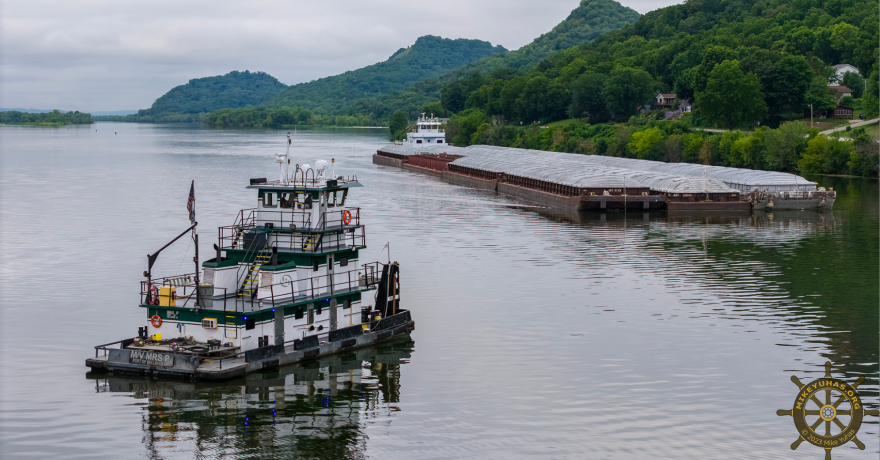The Mississippi River is again facing low water levels — pushing up barge rate and making it more expensive for farmers to export crops and import fertilizer.
Stretched out over 2,000 miles, the Mississippi is essential for farmers to sell their crops. Nearly half of all U.S. corn, soybeans and wheat exports travel down the waterway to the Gulf of Mexico.
Decreased rainfall starting late this summer shrunk the Ohio River, the main water source of the Mississippi. Before that, Mike Steenhoek, director of Iowa-based Soy Transportation Coalition, was hoping the river could avoid a fourth consecutive year of low water levels.
“A lot of the Midwest has received a pretty substantial amount of rainfall, particularly in spring, and really through the middle part of August, drought conditions have reversed considerably,” he said. “But yet we find ourselves in some low water conditions on the lower part of the river.”
Captain Mike Napper, a Mississippi River tug and pull pilot, said that means barges have to carry lighter loads to avoid scraping the bottom of the ship’s hull on the riverbed.
“The less product you take, they got to make more trips to get ‘X' amount of product from point A to B,” said Napper, who currently operates out of a pier in Wisconsin.

The extra trips are making barge travel cost more. By late September, barge rates had already risen significantly above their long-term averages, according to the Farm Bureau. For example, barge rates in St. Louis increased by about 49% from their 2019-2021 averages.
If the river shrinks further as forecasted for October, rates could climb even higher. Among the products impacted would be the fertilizer the U.S. imports.
“Once the fertilizer gets up here, somebody else has got to pay the piper for that extra trip,” Napper said. “On the flip side of that, the fertilizer companies is going to charge the farmer more.”
For farmers, costs are piling up
Paul Freeman, a soybean farmer in central Minnesota, is thinking ahead to next year’s planting season and the fertilizer he’ll need for it. Right now he’s feeling the pressure from the fertilizer spikes and expects next spring to be no different.
“They're going to spread that cost down the line to where the person has to pay it,” he said. “That's me.”

He’s also weighing how he’ll sell his soybeans. He could place his beans on the river to export to countries in Europe, but barge rates aren’t favorable. Typically, he could also send them to China, which historically has been the biggest buyer of American soybeans, but the country is boycotting U.S. beans amidst a trade war.
“That's a big question mark this year with all the turmoil in the markets,” Freeman said.
Chad Hart, an agriculture economist at Iowa State University, said more farmers like Freeman will find themselves squeezed from all directions.
“It's sort of a double whammy for farmers here, they're facing lower prices for their corn and soybeans, if we can't move as fast down the river, but we're also facing higher fertilizer, higher input costs because of that same problem,” he said.
Hart said some farmers are trying to avoid costly fertilizer by buying it early, while others wait, hoping that the price will come down.
“You're just trying to figure out, basically, how to time the market, to try to avoid those pinch points,” he said.
Steenhoek with the Soy Transportation Coalition said farmers are also thinking of different options to export their crops. Instead of the river, they could opt to drive long distances to possibly feed into an area with livestock production or to access a rail loading facility for South American markets.
“So there are additional options, but again, you’re migrating to less favorable options,” Steenhoek said. “Which means there’s going to be a profitability lost anytime that occurs.”
Preventing a fifth year of low water levels
To mitigate low water levels in the future, Gary Williams, executive director of the Upper Mississippi Waterway Association, said the river needs proper maintenance.
“The waterway is vital for trade and export, and it needs to be looked at as being a working waterway and maintained and kept up to date, much like our highway system on the roadways needs to be,” Williams said.
He said that means funding the Army Corps of Engineers to continue dredging the riverbed to keep up with low water levels for barges to move up and down the river. He said this should happen before the river’s water levels get low.
“We’ve seen it before with low water conditions when it returns, it requires redoubled efforts or greater from the Army Corps, to keep everything running,” Williams said.

In the meantime, farmers such as Freeman continue to adapt. He said he’s expanding his local business connections and selling specialty soybeans to Japan.
“That's the first time I specifically knew where my beans were going,” Freeman said.
He expects his crops to generate about a half a million dollars in revenue. But a majority of it will go to paying back operating costs like land rent, insurance and fertilizer application.
“I've got a family to support,” Freeman said. “I've got to pay the rent and pay the mortgage on the land.”
This story was produced in partnership with Harvest Public Media, a collaboration of public media newsrooms in the Midwest and Great Plains. It reports on food systems, agriculture and rural issues.


